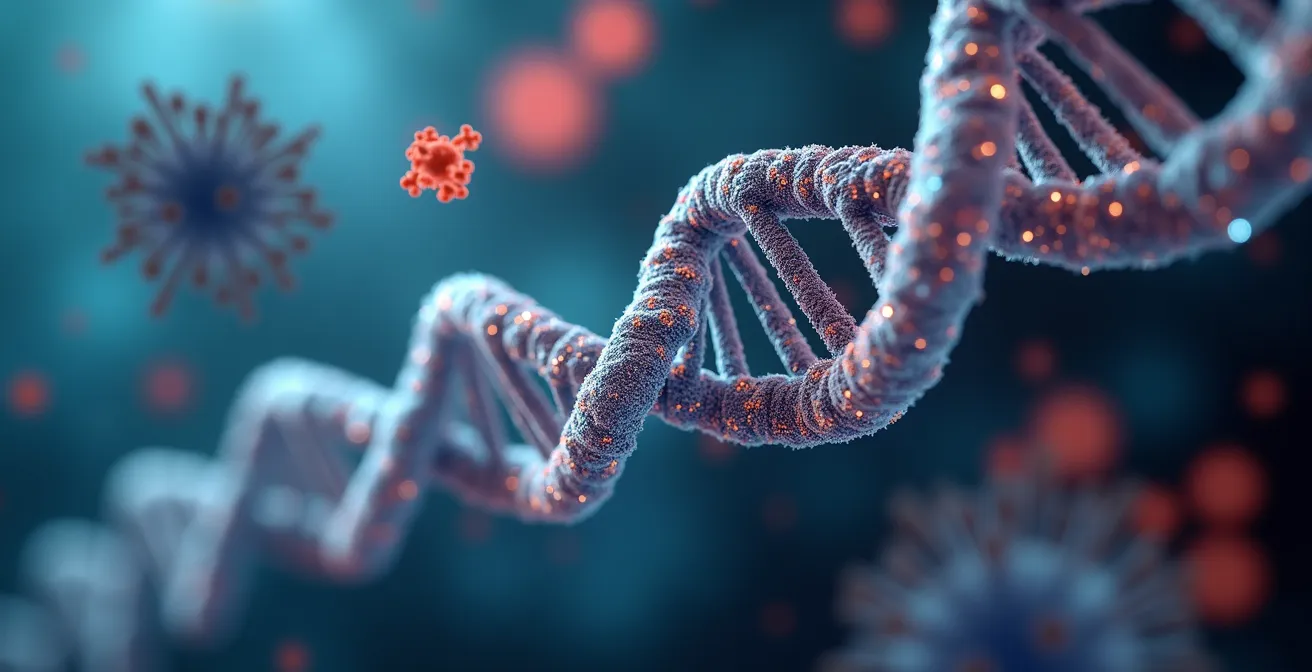The quest for youthful vitality is as old as time, but today’s market offers a dizzying array of anti-aging supplements promising to turn back the clock. Beyond the enticing marketing, a deeper question remains: what is the real science at play? The journey to understanding their efficacy isn’t about finding a single miracle pill, but about tracing the path from the fundamental mechanisms of cellular aging to the practical realities of how a compound is absorbed and utilized by the body. This deeper dive reveals that not all supplements are created equal, and their true value lies in their ability to target the biological processes that define how we age.
Many products address only superficial signs, but a sophisticated approach involves targeting the very hallmarks of aging within our cells. This requires a grasp of which ingredients have credible scientific backing and how they can be integrated into a broader strategy for wellness. Understanding this complex interplay, from the role of specific compounds like those in Hyaluronic Acid Sante Verte supplements to their interaction with our unique biology, is key to moving beyond the hype and making informed decisions for long-term health.
The Science of Anti-Aging in 4 Key Concepts
- Cellular-Level Impact: True anti-aging goes beyond skin deep, targeting core biological processes like DNA stability and cell senescence.
- The Bioavailability Barrier: An ingredient is only effective if your body can absorb and use it; formulation is critical.
- Evidence Over Marketing: Understanding the difference between a lab study and human trials is key to evaluating supplement claims.
- A Holistic View: Supplements are just one piece of the puzzle, alongside genetics, lifestyle, and regulatory oversight.
Unpacking the Biological Clock: How Supplements Intersect with Cellular Aging Mechanisms
To understand how anti-aging supplements might work, one must first look at the aging process itself, not just as the appearance of wrinkles, but as a series of complex events occurring at the cellular level. Scientists have identified several “hallmarks of aging,” which are fundamental drivers of physical decline. These include the shortening of telomeres (the protective caps on our chromosomes), genomic instability from DNA damage, and epigenetic alterations that change how our genes are expressed. Over time, these changes contribute to what we see externally as aging.
This is where targeted supplements enter the conversation. Specific ingredients are theorized to intervene in these core processes. For instance, antioxidants like Vitamins C and E help neutralize free radicals, which are unstable molecules that cause oxidative stress and damage DNA. NAD+ precursors aim to replenish declining levels of Nicotinamide Adenine Dinucleotide (NAD+), a crucial coenzyme for DNA repair and energy metabolism. Meanwhile, collagen boosters provide the building blocks for skin structure, addressing a decline in natural production.

It’s crucial to distinguish between supplements that offer superficial benefits—like temporarily hydrating the skin—and those that may influence these deeper cellular mechanisms. While a moisturizer can improve appearance, a supplement formulated to support telomere health or mitochondrial efficiency is working on a fundamentally different level. A study showing a measurable reduction over 1 year in adults aged 54-84 highlights the potential of certain formulations to impact biological age markers, not just cosmetic ones.
The Cel System supplement range was formulated to target pathways associated with the Hallmarks of Aging when combining Cel1, Cel2, and Cel3 formulas.
– Varun B. Dwaraka et al., Aging Journal
Illustrating this principle, specific clinical research has shown promising results in targeting these aging markers directly.
Effects of Cel System supplement on biological aging markers
A clinical study over 1 year demonstrates the Cel System supplement reduces epigenetic age and improves physical metrics such as muscle strength and body composition in older adults. This research suggests that a targeted nutraceutical approach can influence key biological markers associated with the aging process, moving beyond surface-level treatments. The study provides evidence that specific formulations can produce measurable improvements in health metrics tied to aging.
The Journey from Capsule to Cell: Bioavailability, Ingredient Synergy, and Absorption Realities
An ingredient’s potential is meaningless if it cannot reach its target within the body. This is the challenge of bioavailability—the proportion of a substance that enters the circulation when introduced into the body and so is able to have an active effect. Simply swallowing a capsule does not guarantee that its contents will be effectively absorbed and utilized by your cells. This factor is a major differentiator in the quality and efficacy of supplements.
Different formulations have vastly different absorption rates. For example, collagen is more easily absorbed when it is “hydrolyzed” or broken down into smaller collagen peptides. Similarly, liposomal vitamins are encased in a layer of fat, which can help protect them from degradation in the digestive system and improve their delivery into cells. A review of bioavailability scores shows that hydrolyzed collagen vs peptides and liposomal vitamins range from 3 to 5 out of 5, demonstrating how formulation directly impacts absorption potential.
What is bioavailability and why does it matter for supplements?
Bioavailability is the measure of how much of a supplement your body can actually absorb and use. High bioavailability is crucial because it determines whether the active ingredients can reach your cells to provide their intended benefits.
Furthermore, ingredients do not act in a vacuum. They can interact with each other in ways that are either synergistic (boosting each other’s effects) or antagonistic (hindering absorption). A classic synergistic pairing is Vitamin C and Vitamin E; they work together to enhance antioxidant protection. Conversely, taking high doses of zinc can interfere with copper absorption. As health researchers from Jinfiniti.com note, the context of consumption matters too; for instance, taking fat-soluble supplements like CoQ10 with a meal containing healthy fats can significantly improve how well it is absorbed.
The following table provides a clear comparison of how different supplement formulations can affect their ultimate bioavailability.
| Supplement Type | Bioavailability Score | Notes |
|---|---|---|
| Hydrolyzed Collagen | 4/5 | Good absorption but dependent on peptide size |
| Collagen Peptides | 5/5 | Higher absorption due to smaller peptides |
| Liposomal Vitamins | 4/5 | Enhanced by liposome encapsulation for targeted delivery |
| Standard Vitamins | 3/5 | Variable absorption, depending on formulation |
To maximize the benefits of any supplement regimen, understanding these principles is key. The following tips can help improve absorption and ensure ingredients work together effectively.
Tips for Improving Supplement Absorption and Synergy
- Take fat-soluble supplements with meals containing healthy fats.
- Avoid mixing antagonistic ingredients like high doses of zinc with copper at the same time.
- Combo antioxidants like vitamins C and E may enhance effects synergistically.
- Consider formulations like liposomal vitamins for better cellular delivery.
Navigating the Evidence: Evaluating the Scientific Rigor Behind Anti-Aging Ingredients
In the crowded anti-aging market, separating scientifically validated claims from clever marketing is a critical skill. Not all evidence is created equal, and understanding the hierarchy of scientific research helps consumers assess the real potential of a supplement. Studies range from preliminary *in-vitro* (test tube) research and animal trials to more robust human studies, like Randomized Controlled Trials (RCTs), which are considered the gold standard.
Many popular ingredients have been studied extensively, but the strength of the evidence varies. Key anti-aging ingredients like Hyaluronic Acid, Collagen, Resveratrol, and Vitamins C & E are among the most studied with varying strengths of evidence. Hyaluronic acid, for example, has shown in multiple high-quality studies to reduce visible signs of skin aging. Collagen supplementation has been found to improve skin elasticity and hydration. However, for some ingredients, promising results from lab studies have yet to be conclusively replicated in large-scale human trials.
While many natural supplements show promise in vitro and animal studies, clinical evidence in humans remains limited and requires cautious interpretation.
– M Izadi, Nutrition Research Reviews
This gap between preliminary research and confirmed human benefit is often where marketing language thrives. Phrases like “clinically tested” might simply refer to a small-scale study, not a large RCT. Consumers should look for transparency about the type of research conducted and be wary of claims that seem too good to be true. True efficacy is demonstrated through consistent results in well-designed human studies, not just promising findings in a petri dish.
Key Takeaways
- Aging is a cellular process; effective supplements must target mechanisms like DNA repair and mitochondrial health.
- Bioavailability is non-negotiable: an ingredient’s power is lost if it’s not absorbed by the body.
- Ingredient synergy matters, as some compounds enhance each other’s effects while others may interfere.
- Evaluate scientific claims by prioritizing human clinical trials over preliminary lab or animal studies.
- Supplements are a component of a larger health strategy, not a standalone miracle cure.
A Pragmatic Approach: Supplementation in the Broader Anti-Aging Landscape
Adopting a pragmatic view is essential when incorporating supplements into an anti-aging strategy. The industry’s regulatory landscape is a key factor to consider. In the United States, the FDA regulates dietary supplements as food, not drugs. This means manufacturers are not required to prove efficacy before a product hits the market, placing the burden of due diligence on the consumer. The market’s rapid expansion, with a 12% increase in registered dietary supplement products in 2023, underscores the need for careful selection.
Individual responses to supplements are also highly variable and depend on a multitude of factors. Genetics, diet, stress levels, and existing health conditions all influence how your body absorbs and utilizes a given ingredient. What works wonders for one person may have little effect on another. This highlights the importance of personalization and integrating supplementation within holistic approaches to personal wellness. These elements can be better understood through a summary of influencing factors.
| Factor | Impact on Supplement Efficacy | Consumer Considerations |
|---|---|---|
| Genetics | Modulates individual response to ingredients | Personalized approaches recommended |
| Lifestyle | Affects oxidative stress and absorption | Supplementation must accompany healthy habits |
| Health Conditions | Can alter metabolism and immune responses | Consult healthcare provider for tailored use |
| Regulatory Environment | Determines product safety and claim legitimacy | Prefer products compliant with strict regulations |
Finally, assessing cost-effectiveness and setting realistic expectations is crucial. Supplements should not be seen as a replacement for foundational health practices like a balanced diet, regular exercise, and adequate sleep. When considering the cost, it’s wise to prioritize supplements with strong scientific backing for your specific goals. By doing so, you can make more strategic and sustainable investments in your long-term health as you Explore beauty industry innovations.
Guidelines for Cost-Effective Anti-Aging Supplement Use
- Prioritize supplements with strong scientific backing.
- Discuss with healthcare professionals before starting supplementation.
- Combine supplementation with proven lifestyle changes like diet and exercise.
- Set realistic expectations regarding outcomes and timeframe.
Frequently Asked Questions on Anti-Aging Science
Do anti-aging supplements actually reverse aging?
Current evidence suggests some supplements may slow down markers of biological aging and improve health metrics, but the complete reversal of the aging process has not been conclusively proven. They are best viewed as a tool to support healthy aging.
Are all anti-aging supplements safe?
While many supplements are generally considered safe for healthy individuals, they can potentially interact with medications or cause side effects. It is always recommended to consult with a healthcare provider before beginning any new supplement regimen.
How long does it take to see results from anti-aging supplements?
The timeframe for results varies widely depending on the supplement, the dosage, individual factors like diet and genetics, and the outcome being measured. Some benefits, like skin hydration, may be noticeable in weeks, while changes to cellular health markers may take many months to become measurable.
